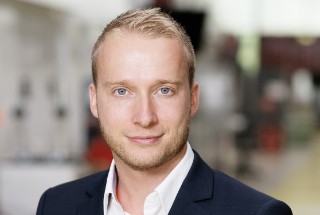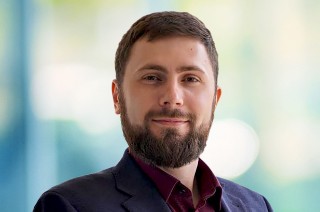1. What inspires your research and what opportunities do you want to tap into?
Lucas Ost: The Mukran project is driven by the urgent need to develop efficient and scalable technologies for storing hydrogen. It is crucial to create safe, reliable, and economical storage solutions given the increasing importance of hydrogen as an energy carrier in the context of the energy transition and the transformation of the energy sector. Our goal is to develop high-pressure-resistant tanks that offer an innovative solution that not only meets current standards but also fulfills future requirements.
The potential we want to tap into lies in improving efficiency, reducing the weight of the tanks, and ensuring their performance under extreme pressure. The aim is to make the hydrogen infrastructure cost-effective and scalable, thereby contributing decisively to a sustainable energy supply. Lightweight construction is a key technology here – and one of our core competencies.
2. What successes or insights from your work to date make you feel particularly optimistic? What exciting challenges are on the horizon?
Felix Kuke: One particularly positive highlight of our work to date concerns the gravimetric efficiency of the tanks – in other words, the ratio of the storable hydrogen mass to the total weight of the tanks. Higher gravimetric efficiency means that the tank can store more hydrogen in relation to its weight. The calculations and tests carried out so far show promising results: we have achieved a 6-percent efficiency in the laboratory for Type IV tanks with a diameter of 60 centimeters, and for larger tanks with a diameter of up to 2.4 meters, an efficiency of as much as 10.5 percent has been calculated. By way of comparison, the U.S. Department of Energy has set targets of 5.5 to 6.5 percent for light commercial vehicles. This makes us optimistic and shows that we are on the right track to making a significant contribution to the development of an efficient hydrogen infrastructure.
Unexpected challenges often arise in research projects, and this project was no exception. One example is the characterization of carbon fiber-reinforced PEEK, a high-performance plastic. In tests, special adhesive plates, known as laminates, had to be applied to the ends of the samples to determine its properties in the direction of the fibers. Since PEEK is difficult to bond at higher temperatures and because the strong fibers that are used generate high loads, many attempts were needed to find the right adhesive and process. So, it was all the more gratifying when a solution was found and the tests were successful – a seemingly simple task that has also proved challenging for other research teams.
Despite these successes, exciting challenges remain, particularly in the modeling and design of thick-walled laminates made of carbon fiber composites and the optimization of the connection technology between the plastic liners that hold the hydrogen in the tank and the so-called boss parts that connect to the valves. These must seal securely and withstand extreme pressures of up to 1575 bars – and, depending on the tank shape, they must be able to be readjusted again and again. These aspects require deeper scientific analysis and the development of new methods to further improve the performance of the tanks and make their production even more efficient.
3. Where could your research have a concrete impact in the future?
Lucas Ost: Germany as an industrial location – and beyond – could benefit significantly, especially in the field of hydrogen storage and utilization. The development of efficient and safe high-pressure tanks for hydrogen storage has the potential to transform the entire hydrogen infrastructure. This would not only revolutionize hydrogen transport and storage in the area of mobility, but also contribute to stationary storage, which in turn supports the expansion of renewable energies.
For industry, our technology opens up new opportunities to reduce production costs, increase the performance of hydrogen technologies, and advance lightweight construction in general. Sectors such as the automotive, aviation, shipping, and rail industries could benefit from the advanced storage options. Our research findings have the potential to lead to lighter, stronger, and more efficient components in other industries, such as the sports equipment industry. Our work therefore not only contributes to hydrogen technology, but also has the potential to promote lightweight construction and material efficiency in many areas.
4. In closing, do you have any insights, thoughts, or perspectives that you would like to share with the professional community or the public?
Felix Kuke: We would like to encourage companies to be more courageous in collaborating with science. Many of our industry partners are already seeking our support to drive innovation forward. Nevertheless, in discussions, especially with SMEs, we often get the impression that good ideas remain on the shelf – often due to a lack of awareness of funding opportunities. For example, it is often not known that all companies in Germany that are liable for tax and engage in research and development activities can receive tax breaks for personnel and material costs within the scope of research expenditures. Research institutions not only offer technical support in such matters, but also help select suitable funding programs and establish contact with project sponsors. They are also happy to provide straightforward advice.
Germany’s innovative strength thrives on the close ties between science and industry. Our aim is to work with companies to gain insights that offer real added value for all involved. The resulting solutions create competitive advantages and thus strengthen the entire economy.
At the same time, we believe that politicians have a duty to create reliable framework conditions. Planning uncertainty due to a lack of budget decisions is damaging to Germany as a center of research and industry. Increasingly complex project management also ties up valuable resources that would be better spent on actual research.


